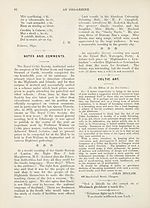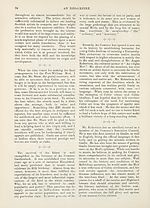An Comunn Gàidhealach Publications > Deo-gréine > Volume 17, October 1921 to September 1922
(101) Page 93
Download files
Complete book:
Individual page:
Thumbnail gallery: Grid view | List view

AN DE6-GREINE.
93
CELTIC ECHOES AND REFLECTIONS.
The provisional syllabus for next Septem¬
ber’s Mod has now been issued, and is, in
every way, a credit to An Comunn and its
officials. The competitions are as numerous
as ever, and the prizes are handsome and
tempting. Everything favours the hope that
the Fort-William gathering will be one of the
most successful ever yet held outside of
Edinburgh and Glasgow, and we trust that
nothing shall happen to mar the fair outlook.
In this early draft, the syllabus lacks one or
two items which imparted much lustre to last
year’s Mod, but there is reason to hope that,
before the next edition is issued, the void
places will be occupied by very gratifying
announcements. There are many wealthy
Gaels connected with An Comunn, and they
are never slow to come forward when the
circumstances seem to warrant a generous
subscription. The directions in which prizes
might expediently be offered may be briefly
discussed, for they are many and various.
The first claim upon our attention is,
probably, that of Celtic art, for hitherto it has
been somewhat neglected by An Comunn
Gaidhealach and other Scottish organisations.
This is due not to lack of sympathy or concern
but to lack of appreciation of our old-world
treasures in sculpture, limning, and other
forms of sesthetic expression. Not one in ten
of the rank and file of our Highland associa¬
tions have the smallest conception of the
wonderful richness of these treasures or of the
great variety of mediums in which they have
been executed. The result is that they give
very little consideration to this phase of Celtic
idealism, and concentrate almost exclusively
on Gaelic music, vocal and instrumental.
Literature is not wholly ignored, but ancient
art is left out of every calculation. Yet, it
has a wealth of beauty and suggestiveness that
places it far above its alien rivals, and entitles
it to a much more handsome treatment than
it ever receives from present-day Gaels.
Some time ago a discussion took place
between myself and certain members of An
Comunn Executive regarding the expediency
of making art a distinctive plank in our
propaganda platform. My contention was,
and is, that it should be entirely separated
from industry, so far as our committee works
are concerned. My reasons were simple and
almost self-evident. Put in a nutshell, they
embraced nothing more or less than the
relegation of industry to its proper custodians
—employers of labour and trade unions—and
the raising of native art to a higher status
than that which it has occupied for many
ages. To try to reconcile the two is vain, and
is quite as futile as to think of running water
up an incline or squaring the circle. Harris
tweeds and Uist hose hold a pretty firm grip
of the market, and need no help from the
dilettants of the Gaelic movement. Hitherto,
my appeals have fallen on deaf ears; and one
leader simply implored me to leave him out
of my proposals—until they came to fruition!
He wished the odium to be mine: but, if the
scheme succeeded, he would like to be in at
the finish! Odium, forsooth, for seeking to
I'estore Celtic art to its due place in our
national civilisation.
No man can square the circle or coax water
up an incline, but to separate art from
industry is a singularly easy task. In fact,
the two were never really united in An
Comunn’s activities, for neither the one nor
the other was ever given any practical atten¬
tion. The spinners and knitters of Uist and
Harris are never a shilling the richer because
we dabble in their domestic trading, for, to be
frank, we know as little about commerce as we
do about art—and even less, if that be
possible. Art is starved, yet the hungry
crofters are not fed; and, by trying to serve-
two masters, both left in the lurch. If we
would confine ourselves to that which right¬
fully belongs to our programme^—the pro¬
pagation of our cultural heritage—we might
be able to exert some little influence on the
modern tendencies of Scottish art. It is in
this direction that I invoke the assistance of
monied Highlanders, and invite them to offer
suitable prizes for the best examples of Celtic
sculpture—designs would be sufficient—and
other distinctive forms of artistic expression.
In what manner could competitions be most
conveniently arranged? According to my
ideas, an art exhibition would form an
apposite adjunct to every annual Mod. It
would be popular and useful, and reflect much
credit on the organisers of our great Gaelic
festival. Awards might be offered for the best
entries, not only for sculptural designs, but
also book and manuscript illumination,
poker-work, modelling in approved mediums,
metal-work, wood-carving, needle-stitching,
embroidery, crochet-work, and so on
93
CELTIC ECHOES AND REFLECTIONS.
The provisional syllabus for next Septem¬
ber’s Mod has now been issued, and is, in
every way, a credit to An Comunn and its
officials. The competitions are as numerous
as ever, and the prizes are handsome and
tempting. Everything favours the hope that
the Fort-William gathering will be one of the
most successful ever yet held outside of
Edinburgh and Glasgow, and we trust that
nothing shall happen to mar the fair outlook.
In this early draft, the syllabus lacks one or
two items which imparted much lustre to last
year’s Mod, but there is reason to hope that,
before the next edition is issued, the void
places will be occupied by very gratifying
announcements. There are many wealthy
Gaels connected with An Comunn, and they
are never slow to come forward when the
circumstances seem to warrant a generous
subscription. The directions in which prizes
might expediently be offered may be briefly
discussed, for they are many and various.
The first claim upon our attention is,
probably, that of Celtic art, for hitherto it has
been somewhat neglected by An Comunn
Gaidhealach and other Scottish organisations.
This is due not to lack of sympathy or concern
but to lack of appreciation of our old-world
treasures in sculpture, limning, and other
forms of sesthetic expression. Not one in ten
of the rank and file of our Highland associa¬
tions have the smallest conception of the
wonderful richness of these treasures or of the
great variety of mediums in which they have
been executed. The result is that they give
very little consideration to this phase of Celtic
idealism, and concentrate almost exclusively
on Gaelic music, vocal and instrumental.
Literature is not wholly ignored, but ancient
art is left out of every calculation. Yet, it
has a wealth of beauty and suggestiveness that
places it far above its alien rivals, and entitles
it to a much more handsome treatment than
it ever receives from present-day Gaels.
Some time ago a discussion took place
between myself and certain members of An
Comunn Executive regarding the expediency
of making art a distinctive plank in our
propaganda platform. My contention was,
and is, that it should be entirely separated
from industry, so far as our committee works
are concerned. My reasons were simple and
almost self-evident. Put in a nutshell, they
embraced nothing more or less than the
relegation of industry to its proper custodians
—employers of labour and trade unions—and
the raising of native art to a higher status
than that which it has occupied for many
ages. To try to reconcile the two is vain, and
is quite as futile as to think of running water
up an incline or squaring the circle. Harris
tweeds and Uist hose hold a pretty firm grip
of the market, and need no help from the
dilettants of the Gaelic movement. Hitherto,
my appeals have fallen on deaf ears; and one
leader simply implored me to leave him out
of my proposals—until they came to fruition!
He wished the odium to be mine: but, if the
scheme succeeded, he would like to be in at
the finish! Odium, forsooth, for seeking to
I'estore Celtic art to its due place in our
national civilisation.
No man can square the circle or coax water
up an incline, but to separate art from
industry is a singularly easy task. In fact,
the two were never really united in An
Comunn’s activities, for neither the one nor
the other was ever given any practical atten¬
tion. The spinners and knitters of Uist and
Harris are never a shilling the richer because
we dabble in their domestic trading, for, to be
frank, we know as little about commerce as we
do about art—and even less, if that be
possible. Art is starved, yet the hungry
crofters are not fed; and, by trying to serve-
two masters, both left in the lurch. If we
would confine ourselves to that which right¬
fully belongs to our programme^—the pro¬
pagation of our cultural heritage—we might
be able to exert some little influence on the
modern tendencies of Scottish art. It is in
this direction that I invoke the assistance of
monied Highlanders, and invite them to offer
suitable prizes for the best examples of Celtic
sculpture—designs would be sufficient—and
other distinctive forms of artistic expression.
In what manner could competitions be most
conveniently arranged? According to my
ideas, an art exhibition would form an
apposite adjunct to every annual Mod. It
would be popular and useful, and reflect much
credit on the organisers of our great Gaelic
festival. Awards might be offered for the best
entries, not only for sculptural designs, but
also book and manuscript illumination,
poker-work, modelling in approved mediums,
metal-work, wood-carving, needle-stitching,
embroidery, crochet-work, and so on
Set display mode to:
![]() Universal Viewer |
Universal Viewer | ![]() Mirador |
Large image | Transcription
Mirador |
Large image | Transcription
| An Comunn Gàidhealach > An Comunn Gàidhealach Publications > Deo-gréine > Volume 17, October 1921 to September 1922 > (101) Page 93 |
|---|
| Permanent URL | https://digital.nls.uk/127171185 |
|---|
| Description | Leabhar 17, Treasamh Mios an Fhoghair 1921 gu Dara Mìos an Fhoghair 1922 |
|---|---|
| Attribution and copyright: |
|
| Description | This contains items published by An Comunn, which are not specifically Mòd-related. It includes journals, annual reports and corporate documents, policy statements, educational resources and published plays and literature. It is arranged alphabetically by title. |
|---|
| Description | A collection of over 400 items published by An Comunn Gàidhealach, the organisation which promotes Gaelic language and culture and organises the Royal National Mòd. Dating from 1891 up to the present day, the collection includes journals and newspapers, annual reports, educational materials, national Mòd programmes, published Mòd literature and music. |
|---|---|
| Additional NLS resources: |
|

